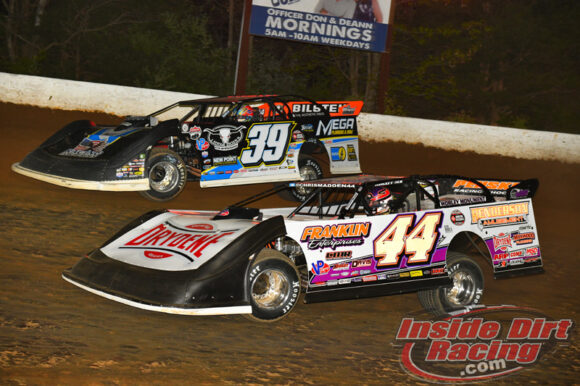A constant theme I broached with those drivers and promoters I spoke with as the 2022 season came to a close was that of whether or not the sport of dirt racing is the same sport it was just a few short years ago. Specifically, I have focused on the time period around the Covid-19 pandemic and the resulting lockdowns, shortages, and changed ways of doing business that went with it across all facets of life. It is my belief that when, a few years from now, fans of racing and competitors alike look back at the current time period we are living in they will conclude that the years 2020 through 2022 made up the most impactful time period in the history of this form of motorsports.
Consider just how much changed in that span and how those newly formed mindsets have been permanently adopted by a sport that has not always been accepting of change. Remember that there were quite a few races held in 2020 that did not even have fans in attendance and greatly limited the number of crew members and media on the grounds. That, in turn, opened the eyes of many in regard to the power and potential profitability of live streaming races over internet broadcast sites.
While attendance at the track will always be important, those fan-less races revealed that racing can go on without packed grandstands. That opened the possibility of racing at times not previously thought of as feasible because of the difficulty in drawing spectators on odd days of the week or to less accessible tracks.
Because of that one change in the way of doing things, enthusiasts of clay-based competition have radically adjusted their way of viewing their favorite form of racing action. The primary way of watching racing is in the process of moving from a grandstand to a screen, if it has not already. While, yes, dirt racing was heading in that direction already, the pandemic simply sped that process up by a few years.
There was hardly a national touring series event, a regional show, or even a local racing program that could not have been watched live away from the track in some fashion this past year. Whether it be on DirtVision, FloRacing, XR or a Facebook “broadcast” shot on someone’s cell phone in the grandstands, a fan with an internet connection could have watched pretty much any race being contested. It’s now just as easy to be a fan from the living room as it is from the grandstands and there’s no travel involved nor lines to the restroom or concession stand to deal with.
But more than just the way we watch racing has changed.
While the racing itself may not be radically different from what it was back in 2019, much of the things surrounding the sport have been reconsidered and some of those changes have been drastic. One of the most obvious differences to have come to light is that of how drivers and teams are paid. During this most recent season, there were more races paying at least $25,000 to the winner than ever before.
Those bigger payouts appear as if they will continue in 2023 with multiple shows set to offer $100,000 or more to the victor. And it’s not just the feature payouts that are seeing boosts. Each of the touring series have been adding to their points funds and are in the process of providing even greater incentives for their regular competitors.
Just last week, the Lucas Oil Late Model Dirt Series announced a Chase for the Championship type of format that will whittle eligible drivers down from an initial field of 15 to a final group of four who will ultimately race for the season title in the Dirt Track World Championship at Eldora Speedway next October(More Details Here). Also, the World of Outlaws NOS Energy Drink Sprint Car Series recently detailed an incentive program that will reward drivers and teams who remain loyal to their tour throughout the year with significant bonus money now available(More Details Here).
In a somewhat similar move, the XR Super Series doubled the payout in its finale at the Las Vegas Motor Speedway from $50,000 to $100,000 as a reward for race winner Bobby Pierce due to the fact that he had participated in all of that sanctioning body’s shows during the 2021 season.
While some promoters have not embraced these changes, others have. Moreover, some of the streaming services and/or sanctioning bodies have leased tracks from the owners for the purpose of running their shows and providing content for subscribers.
Just about a decade ago, an organization called the National Dirt Racing League was formed as a third national touring Dirt Late Model Series. However, the upstart circuit ceased operations in only its second campaign with many believing that this form of racing could not support three national tours. Now, however, there are four national touring series in operation with the traditional Lucas Oil Late Model Dirt Series and World of Outlaws CASE Construction Late Model Series having been joined over the past couple of years by the FloRacing Night in America Series and the XR Super Series.
So what changed?
Obviously, the aforementioned streaming services have brought greater exposure to what was once a form of racing that operated on a much smaller scale than those of more familiar brands such as NASCAR or IndyCar. Those live broadcasts opened the door for racing events to be staged on nights other than Friday and Saturday which then in turn allowed those touring series to schedule in such a way that they could play off of each other rather than against each other.
Further, the increased exposure has opened the door for more sponsors to involve themselves in this form of racing thus providing greater purses and points funds.
But with all of that said, and there has been a lot said so far, the questions of sustainability and pushback have to be considered.
Can this pattern of essentially racing four to five nights per week for major money during the prime portion of the season be maintained by the race organizers, drivers, crews, and equipment for years to come? More than a few drivers and teams participated in over 100 races in 2022 which means there were a lot of grueling race days preceded and followed by exhausting travel. That’s a pace almost beyond human capability.
And perhaps more importantly, will the fans continue to go along for the ride? There are bound to be some who will call the these recent moves anti-traditional and oversaturating. Too many races in too many places are diluting the product and taking significance away from the historic events. The newer features that are paying even higher amounts to win than some of the historic crown jewel shows that have been around for decades are detrimental could be their argument. As said earlier, dirt racing has not always been accepting of change and the changes of late have been coming in rapid fire succession.
Even though change is inevitable, is the pace of change in dirt racing moving too quickly? While it may sound strange to suggest that something in the sport of racing may be moving too fast, perhaps this particular phase of evolution is.
Some may see the evolution of racing that has accelerated since 2020 as a violation of long held traditions and a detriment to a sport that is in the process of straying too far from its roots while may simply see these changes as a natural progression. Evolution is like a train rolling down the tracks that will forge ahead no matter what. And once moved forward, that train will not go backwards. It is now up to those involved in the sport of dirt racing to decide how to proceed from here.
Please consider also reading:
What the Lucas Oil Late Model Dirt Series stands to gain from NASCAR-like Chase format
Respond to this post on Twitter by following @RichardAllenIDR and @MichaelRMoats or by liking the InsideDirtRacing.com Facebook page.
Also, NASCAR and pavement racing fans can check out InsideCircleTrack.







